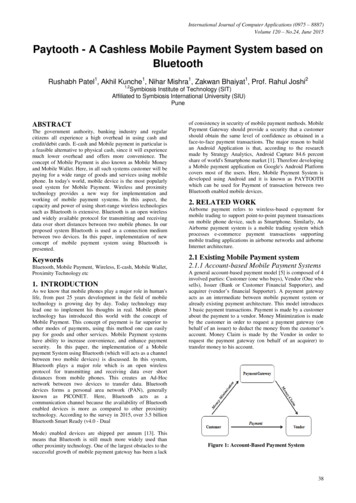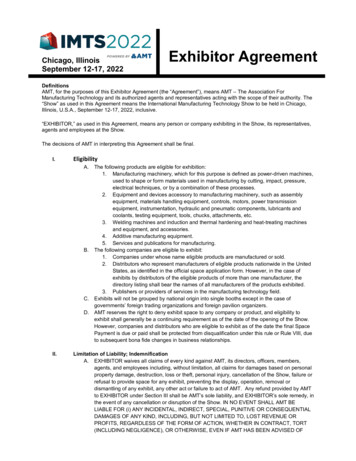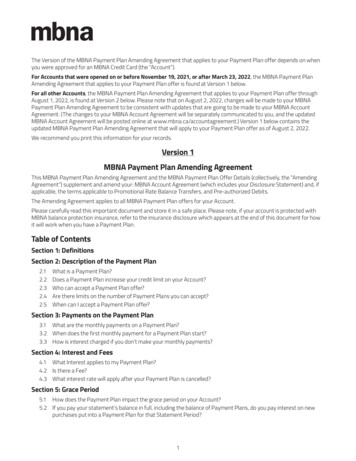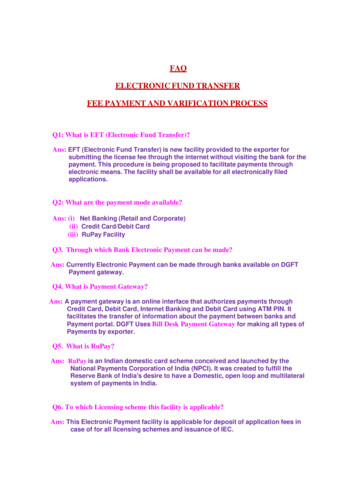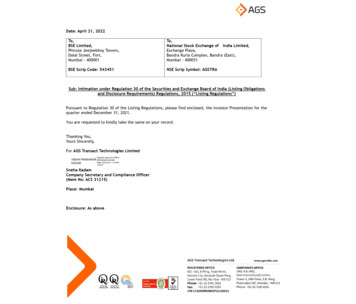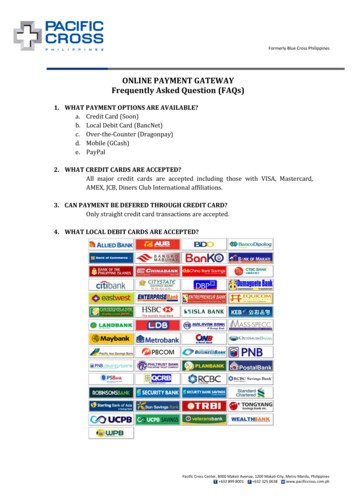
Transcription
The London School of Economics and Political ScienceMobile Payment System:Theory and Cases of Services ModularityNofie Iman Vidya KemalA thesis submitted to the Department of Management of theLondon School of Economics and Political Science for the degree ofDoctor of PhilosophyLondon, April 2016
DeclarationI certify that the thesis I have presented for examination for the MPhil/PhDdegree of the London School of Economics and Political Science is solely myown work other than where I have clearly indicated that it is the work of others(in which case the extent of any work carried out jointly by me and any otherperson is clearly identified in it).The copyright of this thesis rests with the author. Quotation from it ispermitted, provided that full acknowledgement is made. This thesis may not bereproduced without my prior written consent.I warrant that this authorisation does not, to the best of my belief, infringethe rights of any third party.I declare that my thesis consists of 55,608 words.1
ContentsDeclaration1Table of Contents4List of Figures5List of Tables6Abstract71 Introduction91.1Positioning the work in the literature . . . . . . . . . . . . . . . .1.2Research motivation . . . . . . . . . . . . . . . . . . . . . . . . .101.3Aims, objectives, and research question . . . . . . . . . . . . . .111.4Thesis structure . . . . . . . . . . . . . . . . . . . . . . . . . . . .122 Rethinking Modularity in Services10142.1Understanding the context of modularity. . . . . . . . . . . . .152.2Modularity in services: How it differs . . . . . . . . . . . . . . . .242.3On decomposing services . . . . . . . . . . . . . . . . . . . . . . .302.4Service typology and modular characteristics . . . . . . . . . . .352.5Service modules and decomposition logic . . . . . . . . . . . . . .412.6Modularisation aim and strategy . . . . . . . . . . . . . . . . . .482.7Crossing points and the role of customers . . . . . . . . . . . . .513 Research Methodology553.1On theoretical concern . . . . . . . . . . . . . . . . . . . . . . . .563.2Method and approach . . . . . . . . . . . . . . . . . . . . . . . .583.3Justification of the case . . . . . . . . . . . . . . . . . . . . . . .592
3.4Validity and reliability of the study . . . . . . . . . . . . . . . . .4 Mobile Payment as a Modular Service System61644.1The criteria for modular service system . . . . . . . . . . . . . .4.2Technological element of mobile payment system . . . . . . . . .684.3Modularity in organising mobile payment . . . . . . . . . . . . .784.4Comprehensive mobile payment framework . . . . . . . . . . . .835 The Payment Systems Typology65875.1Histories of mobile payment systems . . . . . . . . . . . . . . . .885.2The deployment of mobile payment systems . . . . . . . . . . . .895.3Mobile system and value chain configurations . . . . . . . . . . .945.4Mobile technology and de-verticalisation of industry . . . . . . . 1026 Case Studies6.16.26.36.4105Case 1: Oi Paggo . . . . . . . . . . . . . . . . . . . . . . . . . . . 1056.1.1Country background information . . . . . . . . . . . . . . 1066.1.2The role of government and regulators . . . . . . . . . . . 1096.1.3Organisations and business models . . . . . . . . . . . . . 1126.1.4Technology and architectural design . . . . . . . . . . . . 1136.1.5Overall evaluation . . . . . . . . . . . . . . . . . . . . . . 116Case 2: TCASH. . . . . . . . . . . . . . . . . . . . . . . . . . . 1176.2.1Country background information . . . . . . . . . . . . . . 1186.2.2The role of government and regulators . . . . . . . . . . . 1216.2.3Organisations and business models . . . . . . . . . . . . . 1236.2.4Technology and architectural design . . . . . . . . . . . . 1256.2.5Overall evaluation . . . . . . . . . . . . . . . . . . . . . . 127Case 3: M-PESA . . . . . . . . . . . . . . . . . . . . . . . . . . . 1296.3.1 Country background information . . . . . . . . . . . . . . 1296.3.2The role of government and regulators . . . . . . . . . . . 1316.3.3Organisations and business models . . . . . . . . . . . . . 1326.3.4Technology and architectural design . . . . . . . . . . . . 1346.3.5Overall evaluation . . . . . . . . . . . . . . . . . . . . . . 136Reflections on the case studies7 Synthesising the Research. . . . . . . . . . . . . . . . . . . 1381477.1Revisiting services modularity . . . . . . . . . . . . . . . . . . . . 1477.2Fortune favours modular service firms . . . . . . . . . . . . . . . 1503
7.3Industry-level modularity . . . . . . . . . . . . . . . . . . . . . . 1527.4Calls for mobile payment re-conceptualisation . . . . . . . . . . . 1538 Conclusion1568.1What can we learn from service modularity? . . . . . . . . . . . . 1568.2Significance of mobile payments . . . . . . . . . . . . . . . . . . . 1598.3Theoretical, methodological, and practical contribution . . . . . . 1618.4Limitations and future directions . . . . . . . . . . . . . . . . . . 162Bibliography163Appendix180Technical element of mobile payment system . . . . . . . . . . . . . . 180Coding scheme and description . . . . . . . . . . . . . . . . . . . . . . 193List of interviews . . . . . . . . . . . . . . . . . . . . . . . . . . . . . . 195Interview questionnaire–researcher version . . . . . . . . . . . . . . . . 1964
List of Figures2.1Development of modularity study . . . . . . . . . . . . . . . . . .162.2The process of modularisation . . . . . . . . . . . . . . . . . . . .202.3Activity relationships portrayed in a design structure matrix (DSM) 212.4The diversity of organisational information services . . . . . . . .392.5Service decomposition . . . . . . . . . . . . . . . . . . . . . . . .452.6Modularity types . . . . . . . . . . . . . . . . . . . . . . . . . . .473.1Mobile-cellular subscriptions in Brazil, Indonesia, and Kenya . .604.1Mobile software module . . . . . . . . . . . . . . . . . . . . . . .664.2A typical mobile payment scenario . . . . . . . . . . . . . . . . .794.3Business model framework . . . . . . . . . . . . . . . . . . . . . .855.1Mobile money chart worldwide . . . . . . . . . . . . . . . . . . .916.1Map of Brazil . . . . . . . . . . . . . . . . . . . . . . . . . . . . . 1076.2Oi Paggo design flowchart . . . . . . . . . . . . . . . . . . . . . . 1146.3TCASH kiosk in a shopping mall . . . . . . . . . . . . . . . . . . 1186.4Map of Indonesia . . . . . . . . . . . . . . . . . . . . . . . . . . . 1196.5E-money development in Indonesia . . . . . . . . . . . . . . . . . 1206.6TCASH architectural design . . . . . . . . . . . . . . . . . . . . . 1266.7Map of Kenya . . . . . . . . . . . . . . . . . . . . . . . . . . . . . 1306.8Framework and regulation development . . . . . . . . . . . . . . 1326.9M-PESA basic scheme . . . . . . . . . . . . . . . . . . . . . . . . 1356.10 Adoption of mobile payments in emerging countries . . . . . . . . 1398.1Typical mobile payment structure8.2Technical aspect of mobile payment device . . . . . . . . . . . . . 1835. . . . . . . . . . . . . . . . . 181
List of Tables2.1Modular service design typology . . . . . . . . . . . . . . . . . .424.1Organisations involved in mobile payments . . . . . . . . . . . .814.2Abstraction layer of the framework . . . . . . . . . . . . . . . . .845.1Examples of mobile payment systems . . . . . . . . . . . . . . . .955.2Mobile payment system category . . . . . . . . . . . . . . . . . .965.3Expectations among different mobile payment stakeholders . . . 1006.1Evaluation of service modularity attributes . . . . . . . . . . . . 1176.2Evaluation of service modularity attributes . . . . . . . . . . . . 1286.3Evaluation of service modularity attributes . . . . . . . . . . . . 1376.4Quantitative cases comparison6.5Mobile phone usage in 2011 (% age 15 ) . . . . . . . . . . . . . . 1426.6Qualitative countries comparison . . . . . . . . . . . . . . . . . . 1436.7Comprehensive overview of the case studies . . . . . . . . . . . . 1458.1Selected coding scheme . . . . . . . . . . . . . . . . . . . . . . . . 1948.2List of interviews . . . . . . . . . . . . . . . . . . . . . . . . . . . 1956. . . . . . . . . . . . . . . . . . . 140
AbstractThis thesis applies modularity theory to services using the case of mobile payment systems. We compare three mobile payment projects—Oi Paggo in Brazil,TCASH in Indonesia, and M-PESA in Kenya—as case studies. The study ofmodularity is influenced by literature from the field of production and manufacturing sciences and the present work modifies and extends the theory. Italso demonstrates the potential of modularity theory in managing complexity,increasing flexibility, and achieving efficiency in the service context.Modularity is a principle that shows how a system can be designed withsubsystems while reducing complex interdependencies via standardised interfaces in order to retain efficiency. Modularity offers greater flexibility throughrecombination and efficiency through economies of scale from reusability. Wesought to find how a service provision can be dissolved into coarse-grained service modules that minimise interdependencies and make the whole system morecomprehensible.We argue that, first, the application of modular thinking in services will belikely affected by three key attributes which differentiate services from products: customer involvement, intertwined elements in the final service offerings,and modular packages that incorporate technical and human attributes. Theseanalytical approaches are likely to be valid in those industries that are particularly technology-intensive and incorporate network effects. Second, contrary towhat has been proposed by literature on product modularity, we find empiricalevidence in the case of mobile payments that transactions between participantssuch as customers and regulators were mainly conducted at thick crossing points.This thesis contributes to the emerging literature on modularity in services.First, we test and validate the theory of modularity in services using the caseof mobile payment services. Second, we propose a redefinition of modularity inservices that emphasises the peculiar characteristics of service provision. Finally,7
we propose an indicative proposition for service modularity that can be used tohelp better develop modular services.This thesis also contributes to literature on mobile payments. We posit thattechnology-intensive services such as mobile payments should be developed andmanaged in such a modular way. Not only is it associated with flexibility andagility, modular thinking in services allows companies to maximise compatibilityin fulfilling customers’ needs as well as complying with regulators.Keywords: services, modularity, mobile payment, developing countries8
Chapter 1IntroductionThis is a period of increasing changes in heterogeneity of customer demands andshorter technological life cycles. In the context of management of innovation,the main challenge is to improve flexibility and organisational agility withoutsacrificing operational efficiency.The power of modularity in manufacturing is widely accepted (i.e. Baldwin, 2015; Baldwin and Clark, 2000; Schilling, 2000), but to what extent canmodularity theory explains the dynamics of services sector innovation? Most literature on modularity addresses the manufacturing context and little attentionhas been given to the concept of modularity in services. This study extends theresearch agenda by focusing on the concept of modularity in new service development and assessing the empirical evidence from the case of mobile paymentsystems in developing nations.This study is both timely and relevant. The mobile payment industriesare currently in a transition period where hundreds of tried-but-failed mobilepayment solutions appeared, along with some future promising-but-uncertaininnovative mobile payment solutions being introduced in the market (Dahlberget al., 2008; Dahlberg et al., 2015; Dermish et al., 2012; Evans and Pirchio,2015). This research challenges the generalisability of ‘modularisation’ in product manufacturing into service development and highlights other findings thatare of interest and contribute toward service provision.9
1.1Positioning the work in the literatureModularity is much discussed in the literature of production, organisational, andsupply chain management, but relatively little attention is paid to service modularity (Bask et al., 2010a). Modularity, as core idea in the domain of generalsystems theory, can be defined as “a very general set of principles for managing complexity. By breaking up a complex system into discrete pieces—whichcan then communicate with one another only through standardized interfaceswithin a standardized architecture—one can eliminate what would otherwise bean unmanageable spaghetti tangle of systemic interconnections” (Langlois, 2002,p19). This concept of modularity can be both an organisational characteristicand a technical characteristic, and has implications for both the performanceand organisational structure of firms and industries (see Langlois, 2002).The study of modularity has a long tradition in the context of productionand manufacturing, but recently there is increasing attention to the organisational features of modularity. A few scholars take steps toward adopting thisapproach in the field of services (e.g. Bask et al., 2010a; Brax and Toivonen,2007; Pekkarinen and Ulkuniemi, 2008; Tuunanen and Cassab, 2011; Voss andHsuan, 2009). However, little is known about how service modularity should beunderstood and better developed. Thus, the overall purpose of this research isto study the empirical literature on service modularity, to apply the theory tomobile payments, and to discuss future research opportunities. The underlyingquestion guiding this research is: How is modularity applied in the service context? The approach utilised here is to adopt insights about modularity fromproduction, organisations, and processes, into services.1.2Research motivationThis thesis builds upon and extends the idea that services can be modularised(e.g. Bask et al., 2010a; Böttcher and Klingner, 2011; Carlborg and Kindström,2014; de Blok et al., 2010; Pekkarinen and Ulkuniemi, 2008; Tuunanen andCassab, 2011; Voss and Hsuan, 2009, among others). Modularity in the servicesetting allows service providers to create and deliver new service offerings insuch a flexible and cost-efficient way. Yet, services have not had a properlymodularity treatment. Our central contention, however, is that earlier studies onmodularity are rather static in insights and oversimplify the vision of a ‘modularworld’. Therefore, we need to theorise better about modularity in services. The10
questions we address are about how and to what extent modularity can explainthe dynamics of services sector innovation.We argue that a shift to service modularity has taken place in the mobilepayment industry. This thesis posits that most of the elements that constitutemobile payment systems utilise a modular principle in order to govern complexinteraction among different economic actors. All parts of the system organisecomplex interactions between economic actors and its constituent parts throughmediated interfaces that facilitate flows of information and intense interactions.1.3Aims, objectives, and research questionCentral to this thesis is how actually modularity is applied in the service sectorsettings? In particular,1. How does modularity of services affect the development of mobile paymentsystems?2. How does it work, particularly in the context of developing countries?3. What particular challenges does this context raise and why?4. What explanation which seemed to work?In doing so, the thesis have several objectives:1. To delve into the extent to which modularity is adopted by mobile networkoperators (MNOs), banks, and other financial institutions2. To ascertain factors that contribute and impede the adoption of modularity in developing mobile payment services3. To find out and examine the inhibiting factors that determine the appropriation of modularity in developing mobile payment servicesThe findings of this research will lend support to the knowledge and understanding of service modularity and its application in service development. Inparticular, this study is significant in the sense that it will:1. Allow the identification of the concept and framework of modularity thattakes into consideration the notion of service development2. Support and enrich a theory and model of service modularity that havesimilarities in their nature with product modularity11
3. Provide the framework to examine different combinations of service modularity1.4Thesis structureThis thesis offers an exploration related to introduction of this research, review of relevant literatures, research methodology, cases examination, analysisand discussion, and conclusion. Accordingly the thesis is organised into eightconsecutive chapters.Chapter 1 describes the basis of this research. Research background, motivation, aims and objectives, as well as contributions of this study are elaboratedin this chapter.Chapter 2 critically reviews the field of service modularity. Relevant literatures are comprehensively analysed to give the essential knowledge of servicemodularity and to provide the reader with the present state-of-the-art knowledgein that particular field. This chapter helps to identify a gap in the literature andidentify possible methods, techniques, and theories to fill that gap and furtheradvance the debate. This chapter also unpacks the service provision and elaborates the decomposition logics. It links the theoretical gap between the abstractlevel of the theory of modularity with the lower-level modular framework andcomponents.Chapter 3 unfolds the research methodology being utilised. In addition,the research purpose and objective, research design, as well as data collectionstrategy are presented in detail. This chapter also describes the adopted methodand justification of the reasoning.Chapter 4 studies the modular design thinking in the context of mobilepayment systems. This chapter reveals how modularity works in practice.Chapter 5 focuses on the evolution of mobile payment systems. This is particularly important because mobile payment systems are inter-linked productsthat have precursors and followers. This chapter will also describe the influenceof technological advancements towards the dynamics of payment industry.Chapter 6 is where theory meets practice. It describes the data and resultsfrom the field. This chapter also provides a comparative analysis by contrastingthe empirical case and explaining how the theoretical gap would be bridged byproviding insights from the case.Chapter 7 synthesises the research and formulates the result and analysis.12
Chapter 8 will be the conclusive part of this thesis. This last chapter explainshow our research findings address the research aims and objectives. Additionally, this chapter summarises the original contributions to knowledge of thethesis. Finally, our research limitations and opportunities for future work arepointed out.13
Chapter 2Rethinking Modularity inServicesModularity is a particularly important notion in system design. It is also pivotalin our modern world since the boundaries of current organisational units andfirms are expected to conform the boundaries of elemental technological modules (‘mirroring’). We briefly discuss the theoretical and empirical literature toclarify the notions of modularity in the service settings. We also explore theproblems and limitations of the theory and how can we extend the scholarlydiscussion in this field.The basic argument made by our critics is that current literatures adoptmodular principle from the production and manufacturing in such a carelessway. It did not capture the multi-layered or multi-faceted characteristics ofservices yet. Another major concern among our ctitics is argument-buildingon the design choices underpinning the decomposition of service offerings intomodules is scarce. The final contention by our critics is that if we want to makethe most out of the modular thinking in service development, then we not onlyneed to come up with unified definition, but also clear guidelines on how toutilise the concept in real world situation.The structure of this chapter is as follows. We analyse a formal definitionand application of modularity in Section 2.1. Then Section 2.2 presents thecritical analysis of modularity in service setting. After that, in Section 2.3, wediscuss how services can be decomposed into coarse-grained modules. Section2.4 and 2.5 describes the typology of services and decomposition logic consec-14
utively. Section 2.6 elaborates modularisation aim and strategy, while Section2.7 analyse the role of customer at the crossing points. This chapter devoted toguide the theoretical discussion and the empirical analysis for the remainder ofthe thesis.2.1Understanding the context of modularityAs an attribute of complex systems, the concept of modularity is already wellestablished.1 Modularity captures the degree of breaking apart a complex system into smaller subsystems (modules) that can be integrated in various schemes(Simon, 1962). A modular system is developed on many loosely-coupled components, whilst a non-modular system is made up a one big formation whereeverything depends on everything else (Baldwin and Clark, 2000).This terminology goes back to the design theorist, Christopher Alexander(1964) and the polymath, Herbert Simon’s (1962; 1969) contribution to the design theory. Although they do not use the term ‘modularity’, both propose thedistinction between decomposable and non-decomposable systems, and how tohandle complexity by decomposing those into smaller subsystems.2 Modularityhas been discussed in a wide variety of system types with modular structure setting, e.g. buildings, biological structure, cognitive science, languages, softwareand enterprises, to organisation theory.After Simon and Alexander, Martin Starr (1965) discussed modularity as atrue variety of production strategy to satisfy what markets are looking for. Twoyears later, James Thompson (1967) hypothesises coordination mechanisms usedin response to different pattern of dependencies. In about the same decade, acomputer scientist, David Parnas (1972) suggested modularisation as a tool formanaging complexity in software systems. He put forward the idea of information hiding, where each individual module conceals the information of particulardesign strategy from the rest of the modules in the systems. Interfaces between1 We should not confuse ‘complex’ with ‘complicated’ system. Complicated system tendto be more linear, determined, resulting in such controllable and predictable consequences.Complex system usually more adaptive, resulting in more innovative and unprecedented outcomes.2 Using the watchmakers as an illustration, Simon (1962) studied that a complex systemcould be hierarchically managed as a series of inter-related subsystems until the bottom levelof elementary that we can achieve. Meanwhile, Alexander (1964) observed that no complexsystem will succedd unless they proceed to adapt in subsystem level that independent relativelyto each other. Both credited the idea of ‘selection by components’ to an English psychiatristand a pioneer in cybernetics, William Ross Ashby (1952).15
Figure 2.1: Development of modularity studySource: Authorthose modules are designated to open up as few as plausible of their internal operations in order to minimise coordination costs.3 However, it was Karl Weick(1976) who introduced the notion of loose coupling to organisational studies.He opened up an idea how social organisation interact in exchange relationships, borrowing the conceptual framework that formerly implemented in thecomputer science.The more contemporary study of modularity perhaps can be followed back tothe influential work of Carliss Baldwin and Kim Clark (1997, 2000) on product3 The knowledge about design decision in every module must be limited from the outside.Every team should know everything about their own module but only a few knowledge aboutother modules. As long as the changes only affect hidden partition, they would be considerablyeasier to implement. In the end, information hiding will help in making a complex system notonly more adaptive, but also evolvable.16
architecture and technological innovation; Richard Langlois and Paul Robertson’s (1992) on industries’ innovative potential that are based on modular products, as well as Eric von Hippel’s (1990) work on task partitioning (see Figure2.1). Karl Ulrich (1995) presented the idea of modular architecture that can beidentified by a one-to-one functions plotting to decoupled interfaces and components.4Melissa Schilling (2000) added her contribution by proposing the notion ofreconfigurability of modular systems.5 Although such concepts relate directly tothe study of technological design (Alexander, 1964; Simon, 1962), they becamemore important recently due to the rise of modern technology (Baldwin andClark, 1997). Given the enormous challenges of coordinating complex interdependent tasks, theorists have preferred to suggest that the formal structure ofa design and development organisation ought to ‘mirror’ the configuration of asystem being developed (e.g., Baldwin and Clark, 2000; Langlois, 2002; Ortonand Weick, 1990; Sanchez and Mahoney, 1996; Von Hippel, 1990).6One commonly cited case of inter-firm modularity is the shift in the computer manufacturing sector from a series of vertically integrated business organisations (de-verticalisation) to a group of horizontal sub-industries, for exampleprocessors, CPUs, monitors, hard disk drive (HDD), floppy disk drives (FDD),compact disc (CD), keyboard/mouse, printers and scanners, and applicationsoftware (e.g. Baldwin and Clark, 2000; Miozzo and Grimshaw, 2005; Parnas,1972).In the 1950s, IBM established a Standard Modular System to apply massproduction strategies and rationalising IBM’s complex product line while minimising cost of upgrade for the customers at the same time. This project resultedin IBM System/360 in 1967, which was the earliest computer to be developedas a fully-interoperable modular systems, that not only a technological breakthrough but also an economically profitable (Baldwin and Clark, 2000). Thischange resulted in modular products and process structure that will potentially4 Karl Ulrich’s (1995) definition on modularity tend to be different than the others in a sensethat he relies on a predetermined stable list of functions that making it more appropriate andrelevant in the ecosystems that are more well understood.5 Since a modular system generates heterogeneous outputs from heterogeneous inputs, itwill satisfy consumer demands in variety. However, if the consumers preferred the sameproducts, then modular design probably become irrelevant.6 The first stream of organisational modularity argue that modularity favours vertical disintegration (e.g. Baldwin and Clark, 2000), in accordance with the ‘vanishing hand’ of Langlois(2003). The second stream of organisational modularity posit that modularisation of the complex systems needs knowledge in the particular field and, if outsourcing is possible, will entailtight relationships with the suppliers (e.g. Prencipe et al., 2003).17
disrupt the dominant players and change the industries.Back in those days, there were just three computer projects available, whereall of them were tightly-coupled and densely integrated. Thirty years later,however, there were hundreds of thousands of computer firms developing modules for each other (Baldwin and Clark, 2000). This shift to modular designthen widely spread into other products and manufacturing design, i.e. automobile production (Pine II, 1993), everyday consumer purchases (Arnheiter andHarren, 2006) among others.Even though have been researched in many different settings since the mid1960s, modularisation processes does not always ended up with beautiful stories.7 Modularity has its own pros and cons. On one hand, modularity createthe whole system structure more comprehensible, making it easy to replace thecomponents and distribute work among different groups of designer withoutthem need to know the total structure of the system, which in turn, will reducethe effect that alterations in one part of the system have on the others (Baldwinand Clark, 2000; Orton and Weick, 1990; Parnas, 1972; Sanchez and Mahoney,1996). In the same spirit, Schilling (2000) pointed out the ability of modularprocess to allow various configuration of the systems that will eventually preventvendor lock-in due to standardisation.On the other hand, however, modularity limits the design creativity since itrequires well-defined interfaces, results in less than optimal performance sinceit using generic modules, overuses the same module within too many productvarities, and requires a lot of time and budget in replacing the whole modulewhile only one component (sub-module) within the system is faulty (Arnheiterand Harren, 2006). There is also a possibility of making very costly interfacesfor some very specific modules, while for the system integrators (assemblers) canbe burdensome in assesing the quality and interaction of different modules, thusmaking it difficult to integrate and assemble the modules (Arnheiter and Harren, 2006; Schilling, 2000). Finally, technological advancement does not alwaysgo hand-in-hand accordingly with the higher levels of modularity—sometimes,7 IBM developed a Standard Modular System in the 1950s to allow mass production andreduce cost in manufacturing transistor circuits that resulted in System/360, the first modularcomputer machine, that were binary compatible. Even though the project was a big success,the effort to modularise its system software was a total failure (Baldwin and Clark, 2000).They initially ordered 40 subprojects and
Mobile Payment System: Theory and Cases of Services Modularity NofieImanVidyaKemal A thesis submitted to the Department of Management of the London School of Economics and Political Science for the degree of Doctor of Philosophy London, April 2016. Declaration
